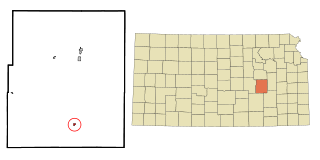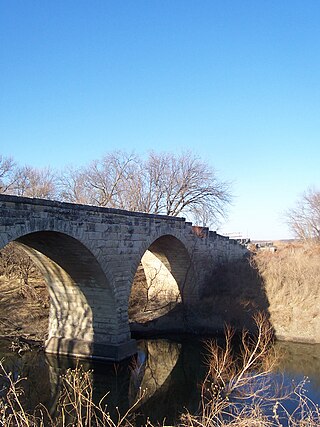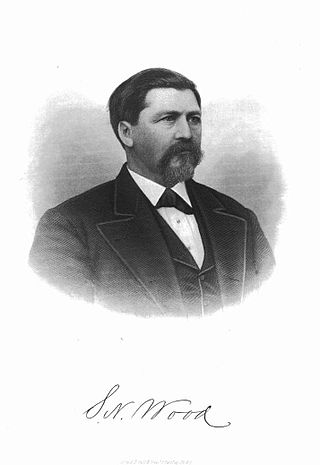
Chase County is a county located in the U.S. state of Kansas. Its county seat and most populous city is Cottonwood Falls. As of the 2020 census, the county population was 2,572. The county was named for Salmon Chase, a U.S. Senator from Ohio that was a Kansas statehood advocate.

Matfield Green is a city in Chase County, Kansas, United States. As of the 2020 census, the population of the city was 49. It is located along K-177 highway.

Strong City is a city in Chase County, Kansas, United States. Originally known as Cottonwood Station, in 1881 it was renamed Strong City after William Barstow Strong, then vice-president and general manager, and later president of the Atchison, Topeka and Santa Fe Railway. As of the 2020 census, the population of the city was 386. It is located along U.S. Route 50 highway.

Manhattan is a city in and the county seat of Riley County, Kansas, U.S., although the city extends into Pottawatomie County. It is located in northeastern Kansas at the junction of the Kansas River and Big Blue River. As of the 2020 Census, the population of the city was 54,100.

The tallgrass prairie is an ecosystem native to central North America. Historically, natural and anthropogenic fire, as well as grazing by large mammals provided periodic disturbances to these ecosystems, limiting the encroachment of trees, recycling soil nutrients, and facilitating seed dispersal and germination. Prior to widespread use of the steel plow, which enabled large scale conversion to agricultural land use, tallgrass prairies extended throughout the American Midwest and smaller portions of southern central Canada, from the transitional ecotones out of eastern North American forests, west to a climatic threshold based on precipitation and soils, to the southern reaches of the Flint Hills in Oklahoma, to a transition into forest in Manitoba.

William Least Heat-Moon is an American travel writer and historian. He describes his heritage as English, Irish, and Osage. He is the author of several books which chronicle unusual journeys through the United States, including cross-country trips by boat and, in his best known work, about his journey in a 1975 Ford Econoline van.
A deep map is a map with greater information than a two-dimensional image of places, names, and topography.

The Flint Hills, historically known as Bluestem Pastures or Blue Stem Hills, are a region of hills and prairies that lie mostly in eastern Kansas. It is named for the abundant residual flint eroded from the bedrock that lies near or at the surface. It consists of a band of hills extending from Marshall and Washington Counties in the north to Cowley County, Kansas and Kay and Osage Counties in Oklahoma in the south, to Geary and Shawnee Counties west to east. Oklahomans generally refer to the same geologic formation as the Osage Hills or "the Osage."

Green Country, sometimes referred to as Northeast Oklahoma, is the northeastern portion of the U.S. state of Oklahoma, which lies west of the northern half of Arkansas, the southwestern corner the way of Missouri, and south of Kansas.

The Smoky Hills are an upland region of hills in the central Great Plains of North America. They are located in the Midwestern United States, encompassing north-central Kansas and a small portion of south-central Nebraska.

Bazaar is an unincorporated community in Chase County, Kansas, United States. It is located about halfway between Strong City and Matfield Green near the intersection of K-177 highway and Sharps Creek Rd.
Verlyn Klinkenborg is an American non-fiction author, academic, and former newspaper editor, known for his writings on rural America.

Blue Highways is an autobiographical travel book, published in 1982, by William Least Heat-Moon, born William Trogdon.

K-177 is a 102.871-mile-long (165.555 km) south–north state highway in central Kansas. It runs from U.S. Route 54 (US-54) near El Dorado northward to US-24 in Manhattan, passing through the Flint Hills. It is part of the Flint Hills Scenic Byway and the Prairie Parkway.

The Library District is an officially designated neighborhood in Downtown Kansas City, Missouri, United States, roughly bounded by 9th and 11th Streets on the north and south and Main Street and Broadway on the east and west. The District contains a sub-district named the West Ninth Street/Baltimore Avenue Historic District listed on the National Register and which includes several buildings individually listed on the National Register of Historic Places. It also contains other notable structures not listed on the National Register.
Fort Drinkwater, in western Chase County, Kansas, was built in 1857 by Orlo H. Drinkwater and W. L. Fowler on Drinkwater's farm. The fort served the area settlers as a refuge during Indian disturbances until 1868. It was built along what called Cedar Creek, or Cottonwood River. In 1862, Drinkwater became the area's postmaster and his fort home served as the post office for several years, until the town of Cedar Point, Kansas, was established a mile to the west.

Clements is an unincorporated community in Chase County, Kansas, United States. It is located about halfway between Strong City and Florence near the intersection of U.S. Route 50 highway and G Rd.

Saffordville is an unincorporated community in Chase County, Kansas, United States. It is located about halfway between Strong City and Emporia near the intersection of U.S. Route 50 highway and Zz Rd. BNSF Railway passes through it.

Samuel Newitt Wood was an American attorney, newspaper editor, and member of the Kansas House of Representatives. He was also a Free State advocate in Kansas and an early supporter of Women's Suffrage. Wood was a speaker at the Pittsburgh, Pennsylvania Convention in 1856 that established the Republican party. He was assassinated in 1891 in a bitter fight over the naming of a new county seat in the state's southeastern corner.
The State of Kansas Notable Book Awards are presented annually for fifteen notable books created by writers, illustrators or book artists who are Kansans or have written about Kansas. The award, originally established in 2006, is organized by the Kansas Center for the Book (KCFB).

















